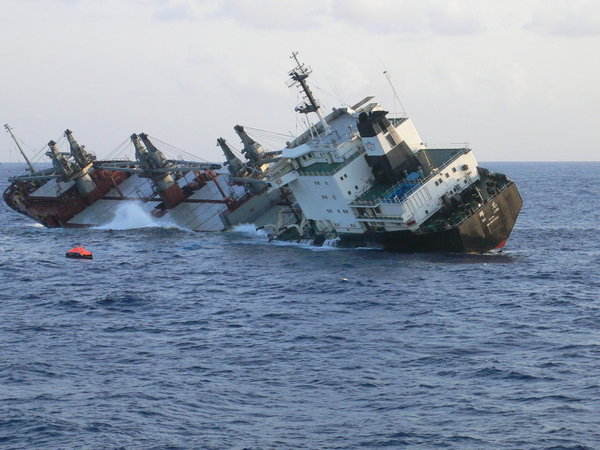3 September 2018
Dynamic liquefaction: a mass movement that can sink ships
Posted by Dave Petley
Dynamic liquefaction: a mass movement that can sink ships
On 18 May 2005, a mid-size bulk cargo ship, the Hui Long, suddenly developed a 15-degree list towards the port side whilst transiting the waters off Sumatra. The ship, which was 158 m long and 23 m wide, was carrying fluorspar in two of its four holds. At the time that the list started to develop, the ship was sailing in a moderate sea, with south-westerly winds blowing at force 5. The ship was rolling on the swell by about 10 degrees to each side of the vertical.
The ship reportedly started to list at approximately 15: 35 on 18 May. The crew responded by trying to right the vessel by flooding tanks on the starboard side. This was unsuccessful, and by 16:02 the list had worsened to 40 degrees to port, at which point the Master decided to abandon the vessel. All crew were successfully rescued, but the ship was lost the following day despite attempts to salvage it.

The severe list of the Hui Long following dynamic liquefaction of its bulk cargo in 1999. The ship was lost the next day.
This is one of many known examples in which bulk carriers have been lost in apparently benign conditions. The events above are described in an article published a couple of years ago (Munro and Mohajerani 2016) that describes case studies in which bulk carriers have been lost due to dynamic liquefaction (and associated processes) of their bulk cargoes. Last week, Susan Gourvenec of the University of Southampton published a nice article in The Conversation that explored this phenomenon of dynamic liquefaction of bulk cargoes, and the resultant loss of the ship. As she notes at the start of her article:
“Think of a dangerous cargo and toxic waste or explosives might come to mind. But granular cargoes such as crushed ore and mineral sands are responsible for the loss of numerous ships every year. On average, ten “solid bulk cargo” carriers have been lost at sea each year for the last decade.”
This dynamic liquefaction phenomenon is the same as the behaviour that we observe in geotechnical materials during earthquakes. Many significant landslides have been associated with this process, such as the multiple failures of loess during large seismic events in central China. Munro and Mohajerani (2016) describe the aftermath of another liquefaction event, on the bulk carrier Padang Hawk, in 1999. Fortunately in this case the ship was saved. The images taken of the cargo after liquefaction occurred nicely illustrate the problem:-

The aftermath of dynamic liquefaction on the Padang Hawk in 1999. Image via TMS Testing
.
In each case, the motion and/or vibration of the ship has induced dynamic liquefaction, just as we see in slopes in susceptible materials when they are subjected to seismic accelerations. Once liquefaction has occurred the cargo starts to move with the rolling of the ship, potentially exacerbating the rolling motion, and creating a feedback loop that allows the situation to worsen. The cargo can drain whilst located on one side of the ship, inducing a permanent list. Once this has happened it is hard to correct the problem whilst at sea.
Sadly, it seems that our understanding of dynamic liquefaction is not being translated across the disciplines to improve safety in ships. Susan Gourvenec explores why ships continue to be lost through this process:-
“The International Maritime Organisation has codes governing how much moisture is allowed in solid bulk cargo in order to prevent liquefaction. So why does it still happen?
The technical answer is that the existing guidance on stowing and shipping solid bulk cargoes is too simplistic. Liquefaction potential depends not just on how much moisture is in a bulk cargo but also other material characteristics, such as the particle size distribution, the ratio of the volume of solid particles to water and the relative density of the cargo, as well as the method of loading and the motions of the vessel during the voyage.
The production and transport of new materials, such as bauxite, and increased processing of traditional ores before they are transported, means more cargo is being carried whose material behaviour is not well understood. This increases the risk of cargo liquefaction.”
It is not obvious that landslide processes can sink large ships, but this is indeed the case.


 Dave Petley is the Vice-Chancellor of the University of Hull in the United Kingdom. His blog provides commentary and analysis of landslide events occurring worldwide, including the landslides themselves, latest research, and conferences and meetings.
Dave Petley is the Vice-Chancellor of the University of Hull in the United Kingdom. His blog provides commentary and analysis of landslide events occurring worldwide, including the landslides themselves, latest research, and conferences and meetings.